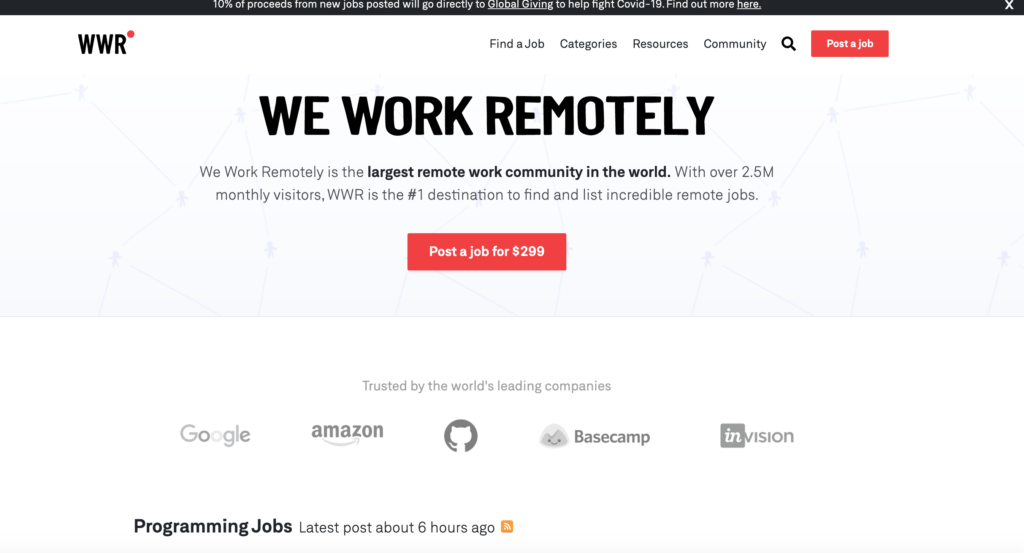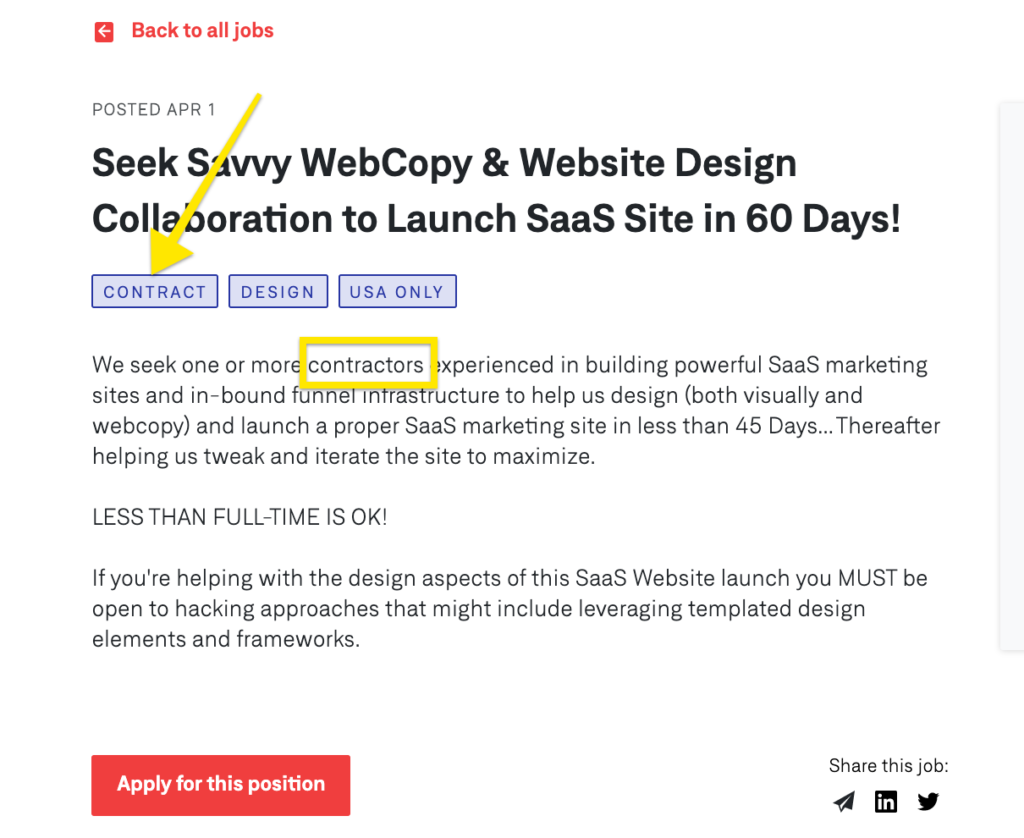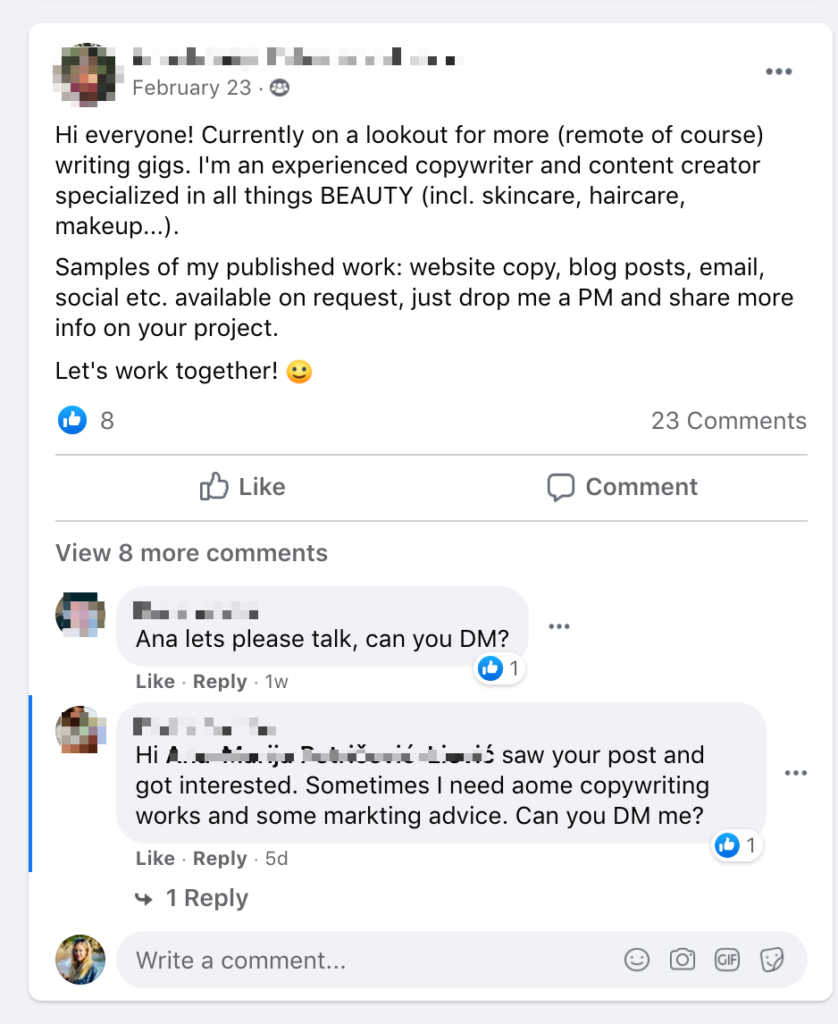Someone once told me that my ability to work remotely was like having a “superpower.”
It kinda is, dontcha think?
When you work remotely, you have the freedom to work from anywhere in the world, be it a white-sand beach in Brazil or the comfort of your own home.
You have the flexibility to skip the commute and sleep in til 10AM. To get up and run errands whenever you feel like it. To travel and visit friends and family at the drop of a hat (*while* working).
I’ve been working remotely for a U.S. company for 3.5 years now and could never go back to an office or location-dependent job.
I’m assuming that you’ve stumbled upon this blog post because you want the remote superpower too.
But before reading, ask yourself this: Do you want to be your own boss… or work for someone else?
There are pros and cons to both, but if having a steady paycheck and benefits are important to you, then you’ll probably want to work for someone else (aka get a remote job).
If that’s the case, then read on!
STEP 1: Decide if you (really) want to work remotely
Before spending every waking hour looking for a remote job, make sure you actually want to work remotely long-term.
If you like the in-person interaction that comes from working in an office, then you might wanna look into short-term gigs, like teaching English online or freelancing, rather than committing to (and spending the time looking for) a full-time remote job that you’ll ditch in a couple month’s time.
Disclaimer: When working from home, I normally don’t look quite as put together as I do in that banner image there. I pretend to look something like this…

“Brainstorming”
In reality, I look a little more like this (only less posed)…

(But alas, I had to look somewhat presentable for the photo, so you wouldn’t think I’m a complete bum).
My point is…it’s nice to not have to dress up for work.
And if I start craving some social interaction, I can go to a coffeeshop or coworking space. Problem solved! (well, pre COVID anyway…).
But that’s me.
If you love the workplace camaraderie or if you’re someone that needs direct supervision to get sh** done, then remote work might not be for you. Give this some serious thought before starting your search.
STEP 2: Decide what you wanna do
Okay, so you’ve decided that you DO wanna work remotely (hooray!). Now, it’s time to decide WHAT you wanna do (if you don’t know already).
Determine your strengths
According to Marcus Buckingham, the author of Now: Discover Your Strengths,
…[a strength is] not something that you’re good at, just like a weakness isn’t something that you’re bad at. A strength is an activity that strengthens you. That you look forward to doing. It’s an activity that leaves you feeling energized, rather than depleted.
Soooo you can be the best magician in the world, but if performing magic tricks leaves you feeling depleted, then it’s not a strength. A true strength makes you feel energized afterward. Fulfilled.
Ask yourself this: What makes you feel fulfilled and energized?
Not sure? Figure it out!
Check out job descrips
So you’ve identified your strengths. Now, it’s time to start mining through job descriptions on remote job sites (more on that in step 5). Write down all of the job titles that sound interesting to you AND use your strength(s).
Think about what it is about the job description that attracts you. From there, you can narrow down your ideal job title even more.
Soooo let’s say social media gets you all excited. Well, then Social Media Assistant would probably be a better title to go after than Marketing Assistant.
Or do you have a secret love affair with Gmail and love the idea of writing emails on a daily basis? Then go after a job specialized in email marketing.
You get the idea.
STEP 3: Figure out when you work best
Are you most productive in the wee hours of the morning? Late hours of the night?
When working with a remote team, you’ve gotta adapt to their schedule. My job requires everyone to be “in the office” during certain hours. I currently live and work from Barcelona, Spain, but I work on Eastern timezone, so I have to be on Slack and available from 8:30AM to 12PM each day (which is 2:30PM to 6PM my time).
One of my colleagues in Vancouver, Canada has to wake up at 5AM each day! Not something I would wanna do, but hey, it works for her.
Some teams are more flexible than others, but more likely than not, you’ll need to be available for collaboration during a few hours of the day.
So if you’re based in Indonesia, you might wanna work for an Australian company instead of an American one. Otherwise, those hours might just kill ya. Ok kidding. But they *will* probably make you really tired and grumpy. Boo.
STEP 4: Create a resume & portfolio that screams “Hire meeeee!”
Your resume is the first impression that employers have of you. So it’s gotta be good.
It should be one page, typo-free, and formatted nicely. Put it in reverse chronological order, with the most important information “above the fold” or at the top of the page.
You don’t have to get too fancy with the formatting. Just use a basic, modern font that’s easy to read. And make sure it’s easily skimmable (so don’t cram too much onto that one page).
Tailor your resume to the job you’re applying to
Your resume should be specific to the job you’re applying to. You want your future employer to read it and think “dang, this is my ideal candidate right here.”
So if you’re applying to be a Technical Support Specialist, then your job testing beer back in college should probs not be on your resume…that is, unless you can somehow demonstrate that your experience as a beer taster made you a better Technical Support Specialist (good luck with that).
No relevant experience yet? Mention the SKILLS you have to offer, any relevant academic projects you may have worked on in the past, and then accompany that resume with a killer cover letter directed to the hiring manager, explaining why you’re perfect for the job.
Oh and when writing that cover letter, try to sound like a person, not a robot.
Pro Tip: Keep one big resume, with ALL your previous job titles, skills and accomplishments. Then when you’re applying to jobs, you can cut and paste from this file to create relevant, hyper-tailored resumes.
Show off your remote skills
Your future employer is going to be looking for signs that you’re able to work without someone hovering over your shoulder. They’ll also want to know that you won’t fall off the face of the earth for hours or days on end.
Soooo you might wanna mention:
1. Online tools
Know your way around Slack, Google Hangouts, Google Sheets, WordPress, Zoom, Zapier…? Mention that. And get specific. So instead of just WordPress, you could mention Gutenberg (the editor for the WordPress platform). That’ll show that you know your stuff more than the average Sue.
2. Portfolio
Link to your portfolio or blog on your resume (more on that below).
3. Side projects & initiatives
Employers like to hire people who take initiative, so side projects are good things to include on your resume. If it’s something that you’re still working on, make it crystal clear that your project won’t distract from the job.
4. Results
Much better to say “Wrote and published 10 blog posts that helped increase traffic by 150% in 6 months” than “Wrote blog posts”.
If you have any results to show from your previous experience, include those. Even better if they’re specific numbers.
Toot your own horn

If you don’t have one already, create a portfolio that shows off your talent. You could also start a blog if you wanna flaunt your writing skills. Or create a few designs if you’re looking for a design job.
When I was just starting out, I had very basic portfolio with links to some papers I’d written in graduate school and my blog. But hey, better than nothing, right?
STEP 5: Start the job hunt
Once your resume and portfolio are good to go, it’s time to start looking for that dream remote job of yours.
Job sites
There are a ton of websites that post remote job opportunities. My personal favorite is weworkremotely.com. Companies have to pay $300 to post an ad on the site, which weeds out the spammy companies.

Here are a few more:
- Flexjobs.com (you’ll have to pay for a membership, but many people seem to think it’s worth it)
- Remote.co
- Workew.com
- Working Nomads
- Angel.co (and filter for remote)
You’ll probably wanna avoid the typical job sites, like Monster and Indeed, since the majority of jobs posted on there aren’t remote.
Social media
And nope, I don’t just mean LinkedIn. Join Facebook groups catered to remote jobs and digital nomads and do a search for your job title. Search on Twitter for keywords like “remote” and “hiring.”

Check out the top companies hiring for remote positions and follow them on social media for updates.
Believe it or not, but I actually found my current job on Facebook (via a Facebook group for remote jobs). I was working as a Proofreader at the time, in an office job that made me pretty mis. I posted in the Facebook group that I was looking for a job as a Virtual Marketing Assistant and my boss responded, saying he was looking for a Content Marketing Specialist.
And get this: I was never even interviewed for the job. I sent my now boss some writing samples, we exchanged a few emails, and boom, just like that, I started working. But I got lucky. That’s def not the norm.
A few lessons I learned from my remote job search
1. Experience isn’t always necessary (and don’t listen to naysayers who tell you otherwise)
Before landing my current job, I didn’t know much about marketing at all. Pretty sure I didn’t even know what a “lead” was.
Although I did have some writing and blogging experience under my belt (if my personal blog counts).
When I told my younger brother that I wanted to land a remote job, he basically scoffed and said (in the nicest way possible), “Good luck…I think you’re going to need to put in time at a company and get more experience before that’ll happen.”
Welp…he was wrong! Just a few months later, I landed my remote job.
SO if you don’t have much experience yet, don’t fret. There are plenty of entry-level remote positions out there that will hire you without experience.
2. Get your foot in the door
I started out as a contractor working just four hours a day, which made it easier for me to get my job. A few months later, I moved into a full-time position.
There’s a ton of competition for full-time remote jobs, so consider looking for a contract (or freelance) position to start out — it’s less of a commitment from the employer’s end, so will be easier to get.

If you want a full-time job, then ask the employer if there’s the possibility to move into something full-time down the road (my boss had told me there was).
3. Try ALL avenues
I got really lucky and somehow a remote job fell into my lap.
But it DOES go to show the importance of trying all avenues (yes, even posting in Facebook groups like this one). Don’t be shy! The worst that can happen is nobody responds.
Be as specific as possible in your post. Say what type of position you’re looking for and link to your portfolio if you want.

STEP 6: Apply, apply and apply some more
If only applying for jobs was easy…sigh. Here are some tips that’ll hopefully facilitate the process:
Don’t skim
Read through the job description carefully before applying. Many employers (including my boss) ask applicants to include something specific in their application that proves they read through the entire description. The ones that don’t follow the instructions are filtered out.
Like so…

Catch that?
Beware of scams
You know what they say: If something seems too good to be true, it often is (well…except in my case).
First and foremost, trust your gut. Check the email address of the hire contact. It should come from a legitimate company domain (ie: john@apple.com). If it comes from a hotmail, gmail or non-company domain, then run for the hills.
Oh and NEVER EVER hand over money, accept checks or pay for something upfront. Some job scams will ask you to pay for your credit report to be reviewed, buy a certain software or deposit a check and then send money elsewhere. Sketchy but sad to say, it happens. Don’t fall for it.
Don’t wanna take my advice? Ok then at least make sure the site is secure before handing over your credit card or personal info (the web address should have a lock icon next to it and it should start with https:// and not http://).

If you’re ever unsure about a company, just do a quick Google search: type the company name + scam. And see what turns up.
Nothing showin’ up at all? That’s also almost a surefire sign it’s a scam.
Stand out from the crowd
The hardest part about applying to remote jobs is finding a way to make your application stand out.
Many remote jobs still require cover letters, but others just ask a series of questions, like “why should we hire you?”
Unfortunately, a thoughtful, personalized application isn’t always enough. So try to get creative and think of ways that you can really knock the socks off of that hiring manager. Surprise them by doing something that they didn’t ask for.
So if you’re applying for a job as a Marketing Support Specialist, you could create a simple website on WordPress, catered to the company you’re applying to, that proves your technical prowess (this is actually how my colleague landed a job at our company).
Or if the position is for a Content Marketing Specialist, you could propose some blog post ideas that you have.
If you aren’t too camera-shy, you could create a video introducing yourself (some companies even require this).
Pro Tip: Create a gmail account (if you don’t have one already). Some companies out there will only consider your application if you apply from an email address that’s gmail.com or your own domain. You see…a gmail account makes you look tech-savvy. Anything else (like Hotmail, AOL or Yahoo) is outdated and just SO 90s.
Don’t get discouraged
As they say, looking for a job is a full-time job in itself. Especially when it’s remote.
It can feel discouraging to get rejection after rejection (or no response at all). I know…I’ve been there. But remember: Everyone gets rejected. All it takes is ONE response. One company. One hire.
Keep learning and improving
When you get rejected, ask the person who emailed you why they didn’t choose you.
Was it due to a typo in your resume? Eek, this happened to me once.
Was your generic cover letter to blame?
Whatever the reason, you might be able to get some helpful feedback that you could use moving forward. I mean, c’mon, whatdya have to lose by asking? My thoughts exactly.
STEP 7: Prep for the interview
So you’ve landed that coveted job interview. YAY! Somehow you’ve managed to stand out from the other applicants and make an impression on the hiring manager.
Now…time to prepare..
Here are a few skills that your hiring managers will wanna see:
1. Self-Management
The hiring manager you speak with is gonna want proof that you can handle projects on your own.
What do you do to make sure that sh*t gets done in your current job? Do you set a task list each week of the tasks you need to complete, prioritized from most to least important? Do you set goals independently and plan projects on your own from start to finish?
These are all things you’ll wanna mention to the hiring manager.
2. Proactive
Remote hiring managers wanna hire people who are self-motivated and take initiative. The ones that don’t have to be asked to do things and instead, just do it. Those that come up with new strategies or ideas without being prompted.
Think of examples of when you took initiative to get something done, professionally or non-professionally.
Like…maybe you wanted to learn Spanish, so started a Meetup group for wannabe Spanish-speakers. Or your previous job required some design skills, so you took a design class in your free time.
Now’s the time to brag!
3. (Excellent) Communication
Long delays in response time and spotty internet connections just don’t fly when you’re working remotely.
After living in Brazil, I learned the hard way how important it is to always have a backup (like a phone hotspot to use for when there’s a sudden power outage).
Oh and this should go without saying, but pay attention to the background of your call too (if you’ll be on video). The last thing you want is to lose a job opp because you had a sloppy bedroom or piled-up dishes in the sink. Make sure that it looks professional. And you look presentable.
4. Tech-savvy
When looking to hire people, my boss asked applicants to send their resume as a link. He was shocked at the number of people that didn’t know how to do that (hint: if you don’t know either, Google Drive and Dropbox are your friends here). Needless to say, he did NOT hire the ones who couldn’t figure this out.
Unless your role is super technical, you don’t have to be a tech wiz to land a remote job. But hiring managers like to hire people who are comfortable trying out new tools and can figure things out on their own.
Because when working remotely, you won’t have an IT department around the corner to come and fix things for you. Nor will you be able to rely on a colleague sitting next to you to walk you through a tool you’re unfamiliar with.
To prove your technical skills, let your interviewer know of the platforms and software that you’re familiar with or your HTML knowledge. Talk about those times when you figured out how to use a tool on your own or do something technical…SOLO!
5. Passion
Okay, not exactly a skill, but equally as important as one. Hiring managers look to hire people who are genuinely EXCITED about the job. If you’re only interested in the remote aspect, they’ll be able to see right through that. And news flash: you won’t last long if that’s the case.
So share your (hopefully genuine) enthusiasm with your interviewer. What makes you stoked about the position and company?
Talk about the ways that you’ve been involved in your industry, whether that’s attending local conferences and meetups; reading blog posts; or listening to podcasts. And ask questions!!!
Story-tell
Come up with a few stories to share with your interviewer that will show off all your remote and job-specific skills, and jot them down in bullet point format. Then practice with a friend to get their feedback.
Why stories? Because stories are more memorable than facts. 22 times so, to be exact.
Also check out the LinkedIn profile of your hiring manager to get inside their head and get an idea of who you’ll be speaking to. If you notice a common interest, you could bring it up in the interview.
STEP 8: Come up with an elevator pitch
Your elevator pitch is a 30-second speech that tells people who you are, what you’ve achieved and what you have to offer. It’s called an elevator pitch because your speech should take no longer than an elevator ride.
Write down your speech and practice saying it aloud so that it sounds natural. You should be ready to share this with anyone in a job interview, on the subway, at a networking event, while out walking your dog, or yes, even on the elevator.
You never know when you might run into someone who’s looking to hire (remotely), so get that speech ready!
“Umm do I need a work permit or visa?”
So you’ve found an awesome remote company (or two) that you’re dying to work for. But…the company isn’t based in your home country.
Now I know what you might be wondering: Will I need some sort of work authorization to work there full-time?
Most likely not. But, as a foreign employee, you won’t be on the company’s payroll either. You’ll technically work as a contractor, not an actual employee (even if you work full time).
But if the company’s a decent one, you should get reimbursed for the same benefits as an employee (like paid time off and healthcare).
There are some companies out there that base the employees’ (and contractors’) salary on where they live. But there are many that don’t. A skill’s a skill, whether you’re in Bangladesh or San Francisco.
My rec? Apply to jobs at companies that are based in countries with a high cost of living (like U.S., Ireland, Australia, England…). And set your sights on companies that determine salary based on performance NOT location. You deserve at least that.



